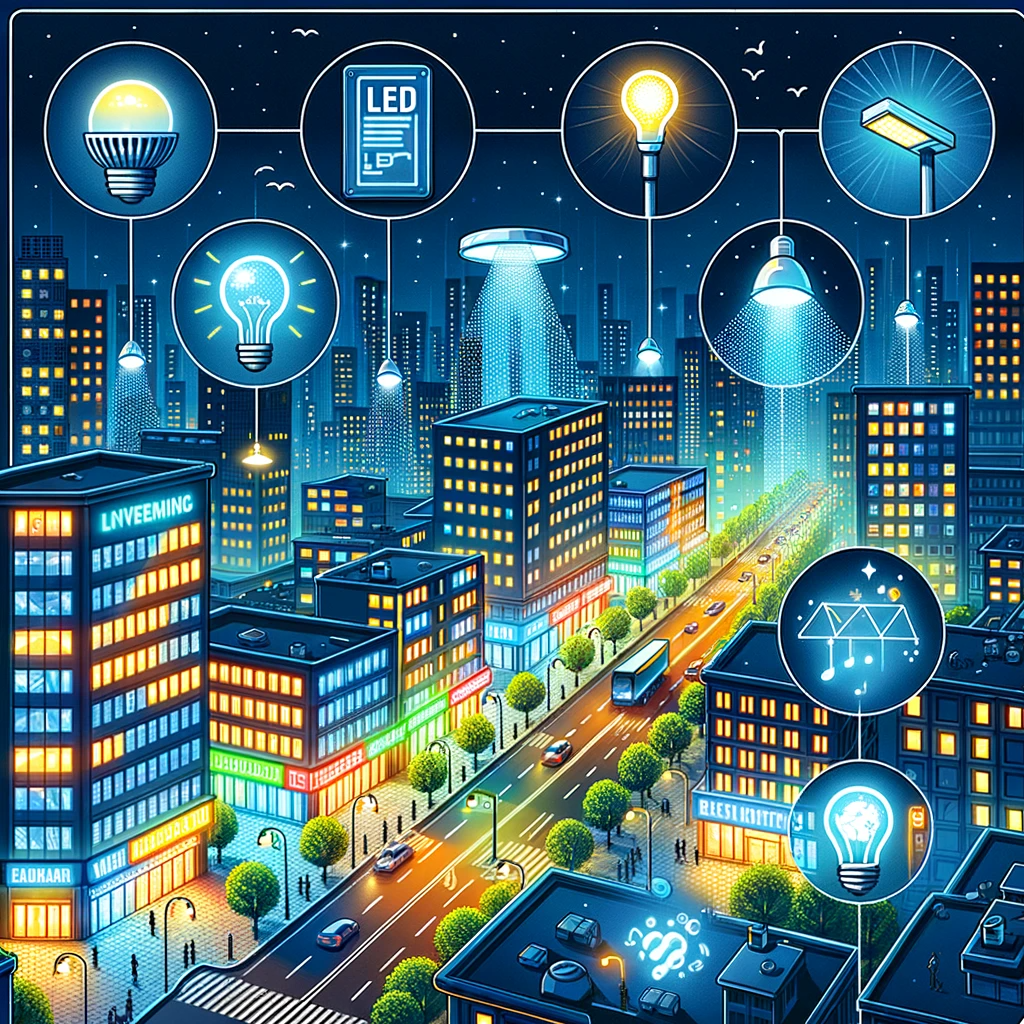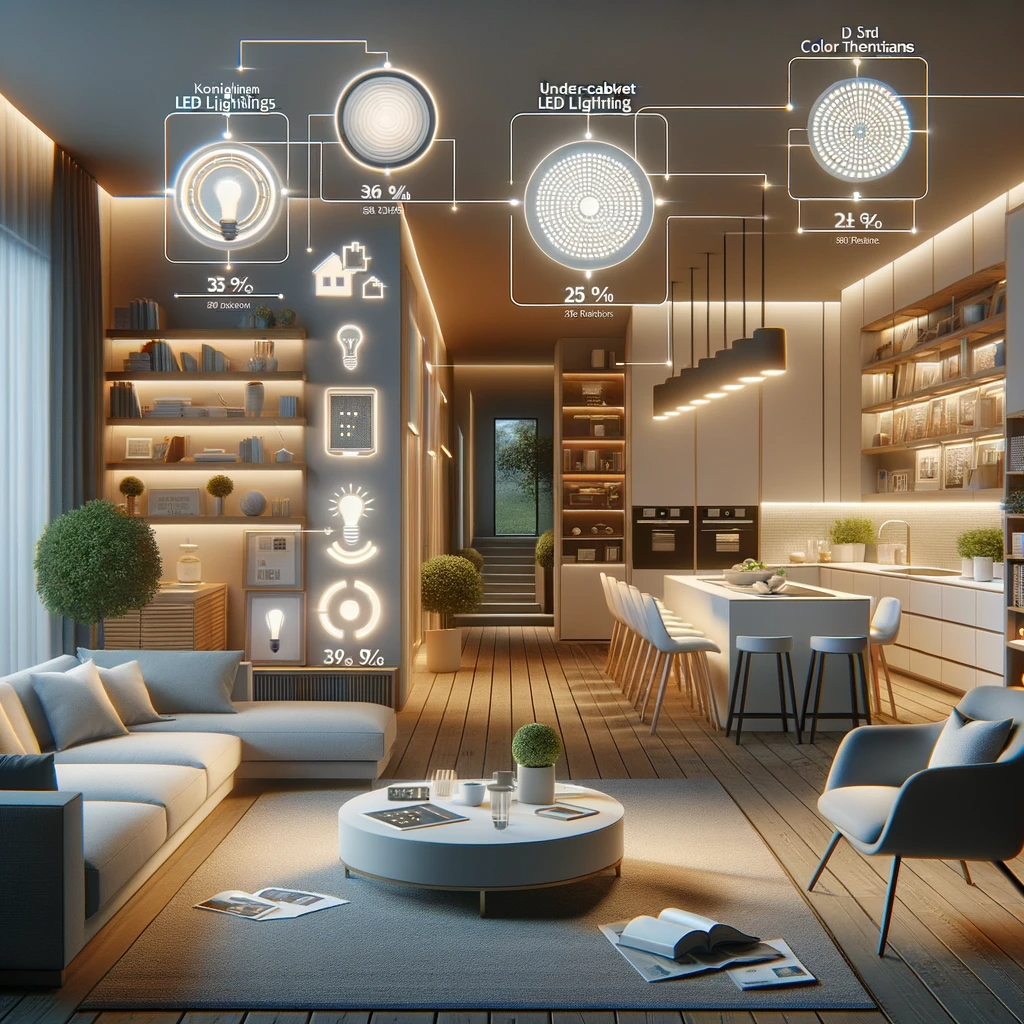Introduction to LED Lighting

LED lighting is a modern and energy-efficient form of illumination. It utilizes Light Emitting Diodes (LEDs) to produce light.
These diodes are semiconductor devices that convert electrical energy into visible light. LED lighting has gained significant popularity due to its numerous advantages over traditional lighting sources.
Definition and explanation of LED lighting

LED lighting refers to the use of light-emitting diodes as the primary source of illumination. LEDs are small, solid-state devices that emit light when an electric current passes through them. They are made up of layers of semiconductor materials, such as gallium arsenide or gallium nitride, which produce photons when electrons recombine with electron holes within the material.
Historical background and development of LED technology
The development of LED technology dates back to the early 1960s when researchers at General Electric first observed electroluminescence in semiconductors. However, it took several decades for LEDs to become practical and commercially viable for lighting applications. The breakthrough came in the 1990s with the introduction of high-brightness blue LEDs by Shuji Nakamura, which paved the way for the creation of white LEDs by combining blue LEDs with phosphor coatings.
Comparison with traditional lighting sources (incandescent, fluorescent, etc.)
LED lighting surpasses traditional lighting sources in several aspects. Unlike incandescent bulbs that rely on heating a filament to produce light, LEDs generate light through a process called electroluminescence without wasting energy on heat production.
As a result, they are significantly more energy-efficient and can last up to 25 times longer than incandescent bulbs. Additionally, compared to fluorescent lights that contain mercury vapor and require ballasts for operation, LEDs do not contain any hazardous substances and do not flicker or emit harmful UV radiation.
How LEDs Work
Science behind LEDs: Semiconductor materials, electrons, photons
Semiconductor materials, such as gallium arsenide or gallium phosphide, are at the core of LED technology. Electrons within these materials have specific energy levels that allow them to participate in the generation of light. When a forward voltage is applied across the semiconductor material, electrons gain enough energy to move from the lower energy level (valence band) to a higher energy level (conduction band).
This transition leaves behind positively charged “electron holes” in the valence band. As electrons recombine with electron holes, they release energy in the form of light photons.
The wavelength or color of light emitted depends on the difference in energy levels between the conduction and valence bands. By carefully selecting different semiconductor materials and controlling their composition, manufacturers can produce LEDs that emit various colors across the visible spectrum.
Role of different components: Diode, chip, phosphor coating
An LED consists of several key components that work together to emit light efficiently. At its core is a diode—a junction formed between two different types of semiconductors (P-type and N-type).
This diode configuration allows current to flow only in one direction through it. The heart of an LED is a tiny chip made from semiconductor material that emits light when energized.
Inside this chip are multiple layers responsible for generating photons during electron-hole recombination. These layers include an active region where electrons and holes combine and give off light.
To enhance LED efficiency and control color output, a phosphor coating may be applied over the chip’s surface. The phosphor absorbs some wavelengths emitted by the chip and re-emits them as broader spectrums or different colors through fluorescence.
Understanding electroluminescence
Electroluminescence is the phenomenon behind the light emission in LEDs. When an electric current passes through the LED’s semiconductor material, it energizes the electrons and creates electron-hole pairs. These electron-hole pairs recombine, releasing energy as photons of light.
Unlike incandescent bulbs that produce light as a byproduct of heat, LEDs emit light directly from an excited electron’s energy transition. Electroluminescence is a highly efficient process because it minimizes energy loss due to heat generation.
As a result, LEDs convert a significant portion of electrical energy into visible light, making them more energy-efficient than traditional lighting sources. Understanding how LEDs work at the fundamental level helps us appreciate their efficiency, longevity, and versatility in various lighting applications.
Advantages of LED Lighting
Energy efficiency and cost savings
LED lighting consumes less energy compared to traditional lighting sources, resulting in significant cost savings. It uses up to 80% less energy than incandescent bulbs and about 50% less energy than fluorescent tubes. This reduction in energy consumption translates to lower electricity bills and long-term financial benefits.
Durability and reliability
LEDs are highly durable due to their solid-state design. They are resistant to shock, vibrations, and temperature fluctuations, making them suitable for various environments.
Unlike traditional lights that rely on fragile filaments or glass components, LEDs have no such delicate parts that can easily break. This robustness ensures a longer lifespan with reduced maintenance costs.
Versatility in design and usage
LEDs offer a wide range of options when it comes to design and application. They come in various shapes, sizes, and colors, allowing for creative lighting designs tailored to specific needs. Whether it’s illuminating residential spaces or commercial establishments, LEDs provide flexibility in installation options—both indoor and outdoor settings—and cater to diverse requirements.
Applications of LED Lighting
Residential lighting
1: General illumination (living rooms, bedrooms) LEDs provide excellent general illumination for residential spaces such as living rooms and bedrooms. They offer a warm and inviting ambience while consuming minimal energy.
2: Accent lighting (highlighting artwork or architectural features) With their directional light output, LEDs are ideal for accentuating artwork or architectural features within homes.
Their precise illumination draws attention to specific focal points.
3: Task lighting (desk lamps or under-cabinet lights)
For focused tasks like reading or working at a desk, LED desk lamps offer efficient task lighting with adjustable brightness levels. Under-cabinet lights provide targeted illumination for kitchen counters or workspaces.
Commercial lighting
1: Office spaces LED lighting in offices ensures glare-free illumination, reducing eye strain and increasing work productivity.
It contributes to a comfortable and well-lit working environment.
2: Retail stores
LEDs are widely used in retail stores due to their ability to showcase products effectively. Their vibrant colors and customizable options enhance visual merchandising, attracting customers and creating an appealing shopping experience.
3: Hospitality industry Hotels, restaurants, and other hospitality venues benefit from LED lighting’s versatility.
It helps create different moods using various colors while maintaining energy efficiency. LEDs also offer long-lasting performance, reducing maintenance efforts in these busy establishments.
1: Streetlights Replacing traditional streetlights with LED streetlights offers numerous advantages.
LEDs provide better visibility, increased safety, and reduced energy consumption for street lighting applications.
2: Landscape illumination
LEDs can enhance the beauty of outdoor landscapes by providing precise illumination for plants, trees, pathways, or architectural elements. They offer a range of colors and intensity levels to create stunning outdoor lighting effects.
Conclusion

With their energy efficiency, cost savings potential, durability, versatility, and suitability for various applications including residential spaces, commercial establishments, and outdoor settings—LED lights have revolutionized the world of lighting. Not only do they provide ample illumination with reduced environmental impact but also contribute significantly to lowering electricity bills over time.
By embracing LED technology in our everyday lives, we can enjoy efficient and sustainable lighting solutions that brighten up our spaces while preserving our planet’s resources for future generations.









